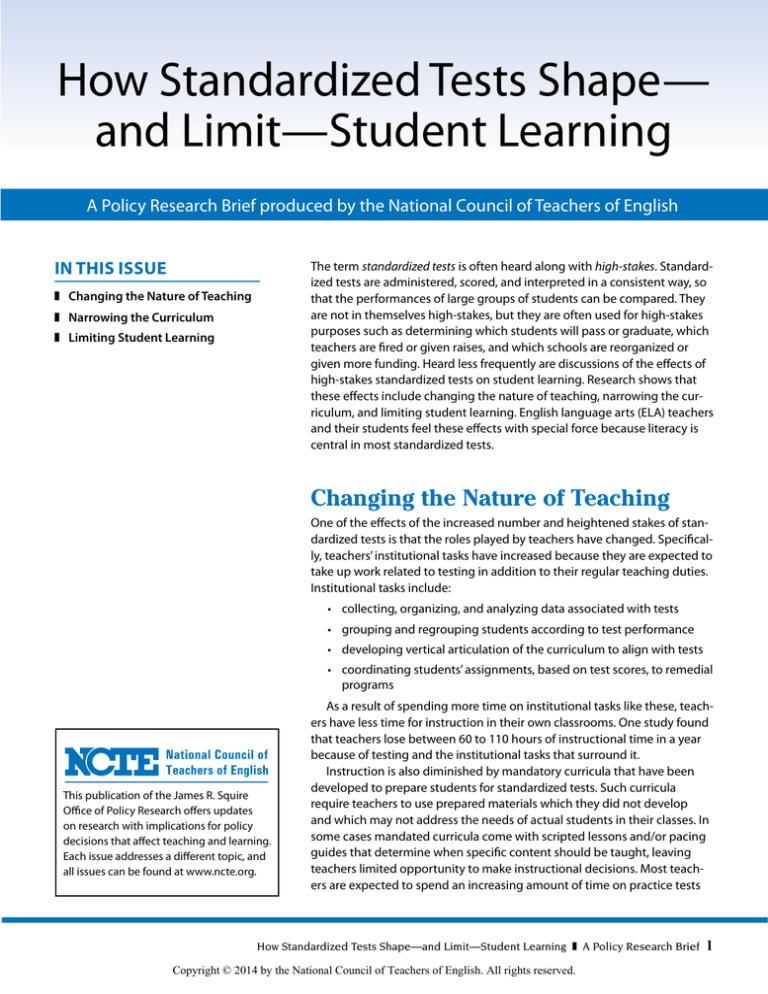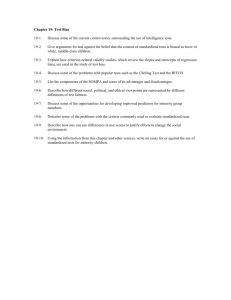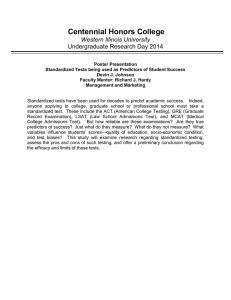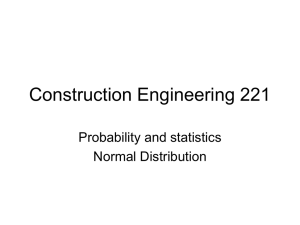
How Standardized Tests Shape—
and Limit—Student Learning
A Policy Research Brief produced by the National Council of Teachers of English
In This Issue
The term standardized tests is often heard along with high-stakes. Standardized tests are administered, scored, and interpreted in a consistent way, so
that the performances of large groups of students can be compared. They
are not in themselves high-stakes, but they are often used for high-stakes
purposes such as determining which students will pass or graduate, which
teachers are fired or given raises, and which schools are reorganized or
given more funding. Heard less frequently are discussions of the effects of
high-stakes standardized tests on student learning. Research shows that
these effects include changing the nature of teaching, narrowing the curriculum, and limiting student learning. English language arts (ELA) teachers
and their students feel these effects with special force because literacy is
central in most standardized tests.
Changing the Nature of Teaching
Narrowing the Curriculum
Limiting Student Learning
Changing the Nature of Teaching
One of the effects of the increased number and heightened stakes of standardized tests is that the roles played by teachers have changed. Specifically, teachers’ institutional tasks have increased because they are expected to
take up work related to testing in addition to their regular teaching duties.
Institutional tasks include:
• collecting, organizing, and analyzing data associated with tests
• grouping and regrouping students according to test performance
• developing vertical articulation of the curriculum to align with tests
• coordinating students’ assignments, based on test scores, to remedial
programs
This publication of the James R. Squire
Office of Policy Research offers updates
on research with implications for policy
decisions that affect teaching and learning.
Each issue addresses a different topic, and
all issues can be found at www.ncte.org.
As a result of spending more time on institutional tasks like these, teachers have less time for instruction in their own classrooms. One study found
that teachers lose between 60 to 110 hours of instructional time in a year
because of testing and the institutional tasks that surround it.
Instruction is also diminished by mandatory curricula that have been
developed to prepare students for standardized tests. Such curricula
require teachers to use prepared materials which they did not develop
and which may not address the needs of actual students in their classes. In
some cases mandated curricula come with scripted lessons and/or pacing
guides that determine when specific content should be taught, leaving
teachers limited opportunity to make instructional decisions. Most teachers are expected to spend an increasing amount of time on practice tests
How Standardized Tests Shape—and Limit—Student Learning A Policy Research Brief
Copyright © 2014 by the National Council of Teachers of English. All rights reserved.
1
or drill sessions to prepare students for tests. Materials and
requirements like these de-professionalize teachers, reducing their authority and autonomy in instruction. Instructional time spent on high-level writing skills such as how
to use strategies of invention in writing is replaced by how
to perform well on the relatively low-level skills required in
standardized tests.
Narrowing the Curriculum
Standardized tests narrow the entire curriculum in many
schools, often squeezing out subjects such as music, art,
foreign languages, and, especially in elementary grades,
social studies, because they are not included in tests. For
ELA teachers, these tests also lead to subject-specific narrowing. ELA teachers are required to focus their instruction on the literacy skills measured on standardized tests.
Since reading is more prominent than writing in most tests,
teachers spend more time on reading rather than writing,
usually focusing on comprehension, not higher-order critical reading skills. Even when English language arts teachers deliberately teach beyond the test-based curriculum,
important aspects of writing such as revision do not get attention, so students read a narrow range of texts and have
limited opportunity to learn strategies for and the value of
revising, rather than just proofreading, their writing.
Standardized tests also limit the type of writing students
do. Many tests of writing include a significant portion of indirect measures such as multiple-choice and short-answer
items that do not require students to write extended prose.
These tests encourage teachers to emphasize a test-based
approach that focuses on the application of a fixed set of
skills, which means that students learn little about processes of composing and rhetorical dimensions such as
audiences and purposes for writing. This limitation is exacerbated by the increasing reliance of standardized tests on
machine scoring. Most prominently, tests developed by the
Smarter Balanced (SB) consortium and Partnership for Assessment of Readiness for College and Careers (PARCC) use
machine scoring to assess students’ levels of achievement
in writing on the Common Core State Standards.
Machine scoring systems can diminish student learning because they tend to prioritize features like mechanical correctness and sentence or word length rather than
more substantive dimensions of writing. This emphasis
on a limited definition of writing is made worse by the fact
that some automated systems identify mechanical errors
inconsistently or erroneously. Student’s in ELA classes do
less high-level learning when instruction is guided by such
narrowly focused and capricious systems.
2
Limiting Student Learning
Most important, standardized tests limit student learning
because they focus only on cognitive dimensions, ignoring
many other qualities that are essential to student success.
Research shows, for example, that GED recipients perform
about as well as high school graduates on standardized
tests but have much worse life outcomes because they
often lack important qualities such as curiosity, conscientiousness, perseverance, and sociability. ELA teachers could
help more students develop these so-called “soft skills” or
non-cognitive abilities if they didn’t have to focus on drills
for tests. Instead, ELA teachers have to, for instance, cut
back on large-scale projects that require perseverance,
reduce the number of literary texts that engender the empathy necessary to sociability, and limit opportunities for
developing student curiosity. Student learning that could
lead in positive directions is diminished when tests prevent
teachers from helping students develop the noncognitive
abilities that support better life outcomes.
Another limitation on student learning results from
the negative perceptions standardized tests can give to
students about themselves and their own abilities. Studies show that elementary school students can begin to
lose their sense of themselves as capable, able to do well
in school and graduate, when they see unknown adults
as controlling the administration and consequences of
the standardized tests they are required to take. Even the
very best ELA teachers have difficulty fostering learning in
students who do not believe in their own abilities.
Student learning is also limited by testing’s inflexible
sorting of students into categories of proficient or notproficient. It can be very difficult for students designated as
not-proficient to imagine themselves as effective readers
and writers. This test-generated binary is troubling because
it gives no space to the full range of features that comprise
effective reading and writing. Students who have literacy
abilities that extend beyond but do not fully encompass
the narrow band of skills measured by standardized tests
may not understand or appreciate their own capacities and
become disengaged from school.
Standardized tests have different effects on various
populations of students, and they usually lead to significant limits on learning among poor and minority students.
For example, the scores of poor and minority students are
often lower than those of middle class whites, and these
results can lead to a failure to graduate, particularly when
these students attend under-resourced schools. Highachieving minority students, particularly high-achieving
African American students, have received relatively little
How Standardized Tests Shape—and Limit—Student Learning A Policy Research Brief
The James R. Squire Office of Policy Research
attention from researchers, but the available evidence
indicates that those who do well on standardized tests do
not think these assessments are accurate or valid measures
of achievement. Rather they are merely a way to “play the
game” of school.
English language learners, currently the fastest-growing
population within US schools, represent another group
whose learning is limited by standardized tests. The results
of standardized tests usually determine whether students
will receive the designation English language learner and
the support services that go with it. Unfortunately, the
tests English language learners take are not always valid
measures of their ability, and their opportunities to learn
are diminished as a result. Instead of receiving the support
they need, students are assigned to classes where their
learning is hampered because they cannot understand the
language being used.
Endnotes
Policy Recommendations
7 Jeffrey, J.V. (2009). Constructs of writing proficiency in US state
and national writing assessments: Exploring variability. Assessing Writing 14, 3-24.
Standardized tests have powerful and often negative effects on student learning, but their negative effects can be
reduced by measures such as these:
• Employ multiple assessments of student achievement so that standardized tests are administered
alongside broader, more comprehensive measures of
student learning.
• Represent standardized tests to students as one type
of assessment among several and help students
understand how this type of assessment functions.
• Ensure that the standardized tests being used are
valid and reliable for the populations of students being tested.
• Provide special accommodations such as allowing extra time, dictation, and translators for English
language learners and other students with special
needs.
1 Valli, L. & Buese, D. (2007). The changing roles of teachers in
an era of high-stakes accountability. American Educational
Research Journal 44 (3), 519-558.
2 Nelson, H. (2013). Testing more, teaching less: What America’s
obsession with student testing costs in money and lost instructional time. New York: American Federation of Teachers.
3 Crocco, M.S. & Costigan, A.T. (2007). The narrowing of curriculum and pedagogy in the age of accountability: Urban educators speak out. Urban Education 42 (6), 512-535.
4 Dappen, L. Isernhagen, J. & Anderson, S. (2008). A statewide
writing assessment model: Student proficiency and future
implications. Assessing Writing 13, 45-60.
5 McCarthey, S.J. (2008). The impact of No Child Left Behind on
teachers’ writing instruction. Written Communication 25 (4),
462-507.
6 Brimi, H. (2012). Teaching writing in the shadow of standardized writing assessment: An exploratory study. American
Secondary Education 41 (1), 52-78.
8 Perelman, L. (2012). Length, score, time, and construct validity
in holistically graded writing assessments. The case against
automated essay scoring (AES). In C. Bazerman, C. Dean, K.
Lunsford, S. Null, P. Rogers & A. Stansell, et al. (Eds), New Directions in International Writing Research (121-132). Anderson, SC:
Parlor Press.
9 Herrington, A. & Moran, C. (2012). Writing to a machine is not
writing at all. In N. Elliot & L. Perelman (Eds.), Writing Assessment in the 21st Century (219-233). New York: Hampson Press.
10 Heckman, J.J. & Kautz, T. (2012). Hard evidence on soft skills.
Labour Economics 19, 451-464.
11 Dutro, E. & Selland, M.K. (2012) I like to read but I know I’m not
good at it: Children’s perspectives on high-stakes testing in a
high-poverty school. Curriculum Inquiry 42 (3), 340-367.
12 Dutro, E., Selland, M.K. & Bien, A.C. (2013). Revealing writing,
concealing writers: High-stakes assessment in an urban elementary classroom. Journal of Literacy Research 45 (2), 99-141.
13 Wiggan, G. (2014). Student achievement for whom? Highperforming and still “playing the game,” the meaning of
school achievement among high achieving African American
students. Urban Review 46, 47-492.
14 Solorzano, R. (2008). High stakes testing: Issues, implications,
and remedies for English language learners. Review of Educational Research 78 (2), 260-329.
This policy brief was produced by NCTE’s James R. Squire Office of Policy Research, directed by Anne Ruggles Gere, with assistance from Ann Burke, Gail
Gibson, James Hammond, Anna Knutson, Ryan McCarty, Chris Parsons, Molly Parsons, Elizabeth Tacke, and Bonnie Tucker.
For information on this publication, contact Lu Ann McNabb, NCTE Policy and Alliance, at lmcnabb@ncte.org or 202-380-3132. ©2014 by the National
Council of Teachers of English, 1111 W. Kenyon Road, Urbana, Illinois 61801-1096. All rights reserved. No part of this publication may be reproduced or
transmitted in any form or by any means, electronic or mechanical, including photocopy, or any information storage and retrieval system, without permission from the copyright holder. Additional copies of this publication may be purchased from the National Council of Teachers of English
at 1-877-369-6283. A full-text PDF of this document may be downloaded free for personal, non-commercial use through the NCTE website:
http://www.ncte.org (requires Adobe Acrobat Reader).
How Standardized Tests Shape—and Limit—Student Learning A Policy Research Brief
3





